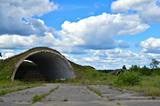The entire history of the Vaiņode airfield
Something fell out of the airplanes. I thought that it might be candy for the aviation festival. I left the cows and ran to get some candy, but the cargo parachutes didn’t open. I stopped after 50 metres. There were great explosions, the earth rose into the sky. It was a German bombardment. They bombed the airfield, turned around over the Kalši swamp, and left.
In 1910, in Rīga, manufacturing of aeroplane engines began at a factory of the Russian Empire, because Rīga was seen as an aviation metropolis in the empire. The early 20th century was when aviation took wing, so to speak, all over the world. For the first time in the history of war, there was now a way to kill people from the sky. Zeppelins could carry enormous weight, including huge bombs that were dropped on various objects. The Wright Brothers were the first to take to the skies in 1903, but in 1914, German aviation specialists chose Vaiņode in the Western Courland highlands as the best place for a dirigible base. The facility was built for the war industry under the leadership of the engineer Emil Weber. Zeppelin hangars called “Valters” and “Valhalla” were completed in 1916, and the Germans installed a rail spur between the station and the airfield. The Vaiņode airfield became the only dirigible base in Europe. After World War I, home guardsmen and aviators in Latvia former their own clubs, and this encouraged people in Vaiņode to think about what to do with their airfield. The new era began in January 1936, when work began on the first glider, “Pārsla.” Every year in July, Vaiņode held an aviation festival in commemoration of its first flight. The glider was proposed and built by Žanis Krūza from Baznīcas Street. On September 15, a hangar for the glider was completed.
An eyewitness: “It was June 1941, and I was out in the field with the livestock. Many aeroplanes appeared above the airfield, with yellow wings. I chased the cows aside. Something fell out of the airplanes. I thought that it might be candy for the aviation festival. I left the cows and ran to get some candy, but the cargo parachutes didn’t open. I stopped after 50 metres. There were great explosions, the earth rose into the sky. It was a German bombardment. They bombed the airfield, turned around over the Kalši swamp, and left. The road from the airfield was too narrow for rock carriers, people ran hither and yon. There were horses with broken carts. The Russians retreated in panic, and they didn’t blow anything up. A day later, a group of Russian soldiers with weapons arrived. They left their truck at the dairy and went into the garrison. I heard some shots, and a clothing warehouse caught fire. The next day, a huge pole of fire rose above the munitions warehouses at the graveyard – there were three such columns in all. The windows in our house were all broken, and the wave of the blast threw us against the wall.
Latvian aviators had only been involved in the war against Bermont’s forces after World War I. The expensive aviation supplied by the Latvian state was never used once World War II began. After the war, the Vaiņode airfield was greatly expanded and used as an aviation base for the Soviet Union. Today it is privately owned and can be visited if the owner is called first on 2922-9743.
| Tourism objects involved in this story | ||
|---|---|---|
During Soviet times, Vaiņode was the site of one of the Soviet Union’s largest military airfields in the Baltic States. During the period of Latvia’s independence, the country’s first dirigibles were based here. Eventually their hangars were dismantled and brought to Rīga, where they were used for the Rīga Central Market. They are still there today. Some of Latvia’s first gliders took off from Vaiņode. During the Soviet occupation, the airfield was home to an air defence and destroyer squadron, with 38 SU-27 “Flanker” destroyers on site. After the restoration of Latvia’s independence, the Vaiņode airfield was dismantled in part, and the big plates of concrete that covered the runways and the rest of the airfield were used to improve the Liepāja port. There are still 16 hangars at the airport, and 1,800 of the formerly 2,500 metres long runway are also still there. More information about the airfield can be found at the Vaiņode Regional Research Museum. |
||









